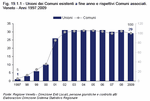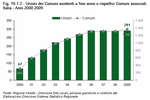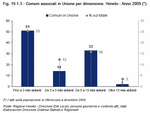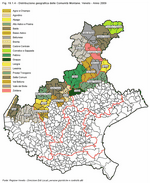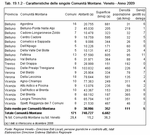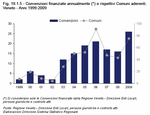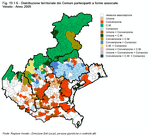(Note 1) In recent decades, institutions have become increasingly aware that they need to participate more in the life of citizens and to gear policy towards satisfying their needs; furthermore the law has been adapted so as to make administrations themselves more functional (see the chapter on services) by providing incentives for more streamline and effective forms of management through the sharing of skills and resources among the authorities involved.
In this way, opportunities were made available to local authorities to interact by activating one or more forms of association, organised as
Ambiti Territoriali Ottimali (Optimal Territorial Environments, ATOs), which were established on the basis of spatial proximity and/or kind of functions/services managed. The model for relations among local authorities in Veneto envisages a variety of forms: Conventions, Consortia, Unions of Municipalities and Mountain Communities.
Inter-municipal associations began to develop in Veneto and in other Italian regions, especially in the North, in 2000 with the coming into force of Legislative Decree D.Lgs. 267/2000 (TUEL -
Testo Unico degli Enti Locali - Single Text of Local Authorities); this law was designed to lower the cost of institutional fragmentation (small and very small municipalities), as well as to form geographic areas where the functions and services of each institutional level could be managed more effectively. With this favourable legislation, the basis was laid for the establishment of
functional federalism that proceeds alongside the introduction of
fiscal federalism.
Today, inter-municipal networks involve 70% of Veneto municipalities, which participate in one or more forms of association. Before describing the fabric of associations created by Veneto municipalities, the various forms of association are briefly explained in order of increasing organisational complexity.
Conventions are the least structured and demanding model of association for local authorities; they are also characterised by being less stable over time than the other forms of association. Regulated by Art. 30 of the TUEL, they do not create a legal person, but are instead of an exclusively contractual nature, so they have no administrative bodies or organisation of their own. Normally they are monofunctional, i.e. they are formed to carry out a single purpose.
Consortia, like Conventions, are monofunctional, but the function performed has to be of an economic or entrepreneurial character. Often the law requires their establishment to provide a specific service. Unlike Conventions, they have the legal personality of a local authority and, thus, they have their own administrative bodies and structure based on the provisions of Art. 31 of the TUEL.
In many cases, Conventions and Consortia precede the establishment of a more structured form, such as a
Union of Municipalities (Art. 32 of the TUEL). Unions are the most organised and stable of the association models and have a polyfunctional character, i.e. they normally perform more than two functions. However, they do not form an additional administrative level with their own autonomous resources, since they are a direct extension of the Municipalities, from which they receive their human and financial resources.
Finally in Veneto, due its partially mountainous physical geography, inter-municipal associations established as
Mountain Communities, or Unions of Mountain Municipalities, take on particular importance; these are regulated by Art. 27 of the TUEL and were established in Veneto by Regional Law LR no. 19/93. As to their character, Mountain Communities are similar to Unions of Municipalities, but they form an autonomous additional and compulsory administrative level. This compulsory nature derives from the fact that they perform functions conferred by the State or delegated by regional government. Functions are often delegated to Municipalities belonging to a Mountain Community as well, when it is decided to entrust the community with the performance of specific functions that are of regional competence.
Below are presented some descriptive statistics on the forms of association present in Veneto. It needs to be kept in mind that the analysis is based on data concerning associations that have been granted at least one regional appropriation by Regione Veneto's Direzione Enti Locali (Local Authorities Directorate) for managing municipal functions or services. Thus, the data do not cover the entire universe of inter-municipal associations present in the region, especially Conventions and Consortia, in particular in regard to urban policing performed by local authorities, which receives further investigation in the following section. Finally, Municipalities themselves can participate in more than one form of association to manage various functions.
 Unions of Municipalities
Unions of Municipalities
As a result of D.Lgs no. 267, Unions of Municipalities have experienced constant growth since 2000, both on a national level and in Veneto. Growth in Veneto stopped in 2002, after a rapid initial rise saw the number of unions triple after 2000.
On a national level, on the other hand, an increase was recorded through to 2005, probably due to different timeframes used by regional incentive policies.
In any case, the phenomenon stabilised in 2006, with 291 authorities nationally, of which 29 (10%) were in Veneto; since then, there has been a limited turnover, that is there is a degree of stability in the unions that were established, which demonstrates the positive view of the associations by local authorities. It is unlikely that a decision would be taken to dissolve the Unions and their advantages surrendered
(Figure 19.1.1) and
(Figure 19.1.2).
Even though in Veneto in 2009, the average number of Unions of Municipalities (3.4) was lower than the national average (4.7), the percentage of the population residing in Municipalities belonging to this form of association in the region was higher (10% in Veneto compared to 9% in Italy). There was no difference, however, between the national share concerning the percentage of member Municipalities (around 17%) or the average number of inhabitants per Union (nearly 17,000)
(Table 19.1.1).
Focusing on Veneto, it can be seen that only the Municipalities of the province of Treviso had not established any Unions; however there were Unions in all of the other provinces: the largest concentrations of this form of association were recorded in the provinces of Padova, Verona and Vicenza, with 9, 8 and 7 Unions respectively (38, 28 and 19 member Municipalities respectively). The land surface area involved covers 1,948 km2, equal to 11% of the total land surface of Veneto.
At the end of 2009, there were a total of 100 Municipalities belonging to Unions, of which 65 had a population of fewer than 5,000 inhabitants. In fact, it is principally the small size municipalities that join: overall 17% of Veneto Municipalities belong to a Union; however if we only look at the membership of Municipalities with fewer than 3,000 inhabitants, the figure rises to 25%; only 3% of Municipalities with populations over 15,000 belong to a Union
(Figure 19.1.3).
Finally, with regard to the municipal functions managed by forms of association, they mostly concern technical services for land management and social services, as will be seen in the last part of this section. On average, a Union manages 6.7 functions
(Note 2).
 Mountain Communities
Mountain Communities
At the end of 2009, Veneto had 19 Mountain Communities, which encompassed 171 member Municipalities (nearly 30% of all the Municipalities in Veneto, compared to the 17% of Municipalities in Veneto belonging to Unions); 154 of these had delegated powers (it was said above that Mountain Communities may manage functions delegated by Municipalities besides performing their own functions)
(Figure 19.1.4).
Mountain Communities cover the province of Belluno and areas of the provinces of Verona, Vicenza and Treviso (more than one-third of the total surface of Veneto, versus little more than 10% of the area covered by the Unions of Municipalities). The area covered by a Mountain Community, which is also involved in planning, is generally greater than that of a Union of Municipalities, both in terms of geomorphology and authority: while Unions of Municipalities have an average surface area of 67 km2, Mountain Communities have an area of 352 km2, with a maximum of 661 km2 for the Community of Agordina and Belluno; likewise, Mountain Communities have on average 38,986 inhabitants and 9 member Municipalities versus 16,654 inhabitants and 3 member Municipalities in the Unions
(Table 19.1.2).
Regarding the functions delegated by Municipalities, there are Mountain Communities that manage a significant number of services for all, or nearly all, of the Municipalities belonging to the association (for example, Belluno's Feltrina Mountain Community of has 11 delegated functions); others, on the other hand, have a limited number of functions (for example Belluno's Ponte nelle Alpi Mountain Community has only one delegated function). On average, each Mountain Community manages 5 functions delegated by the Municipalities. By content, they concern primarily the management of land, accounting and administration (see the last part of this section).
 The other forms of association
The other forms of association
Conventions and Consortia are the other forms of association used by Municipalities to perform their services and functions. The regional promotion of associations, aimed both at the establishment and enlargement of associations among Municipalities, has certainly contributed to the growth of these lesser, more flexible forms as well, which, as was said above, can be established as a preliminary step towards more structured forms, such as Unions of Municipalities and Mountain Communities.
The data used refer to the analysis of Conventions and Consortia established for at least 5 years. Overall, 140 Conventions were financed between 1999 and 2009
(Note 3), of which 112 were still active in December 2009. The trend over time demonstrates a significant increase between 2003 and 2006, followed by a decline in the next two years, and then a rapid recovery in 2009 (the year with the highest number of Conventions founded). An analogous trend is seen in the number of Municipalities belonging to Conventions
(Figure 19.1.5).
Concerning Consortia, there are only 9 for which we have information, because they received regional funds, in the 2004-2009 period. Overall, Consortia managed 15 functions on the behalf of 109 member Municipalities. Normally, but not necessarily, both Conventions and Consortia perform only one function. The kinds of services performed most frequently concerned land management, public works and information systems (see below).
 The fabric of associations in Veneto: an overview
The fabric of associations in Veneto: an overview
Looking at all the principal forms of association in Veneto on 31 December 2009, 73% of the Municipalities were involved in the association management of municipal functions/services
(Figure 19.1.6).
Small Municipalities, i.e. up to 5,000 inhabitants, chose predominantly a Mountain Community (41%) or a Convention (35%) as the form of association management for their functions and services. However, a significant share (21%) also chose a Union of Municipalities, which has more members from among the smallest Municipalities in particular: 65% of members of Unions had fewer than 5,000 inhabitants (the figure rises to 95% on a national level). The Consortium form of association is, on the other hand, particularly widespread in Municipalities with a population between 5,000 and 15,000 inhabitants: more than half of the Municipalities in Consortia belong to this category
(Table 19.1.3).
Of the functions managed through forms of association
(Note 4), those performed most frequently by all of the associations concerned were land, environment and traffic management. By form of association, the most common functions were social services for Unions of Municipalities; administration and accounting for Mountain Communities; and information and statistical services for Conventions and Consortia
(Figure 19.1.7).






